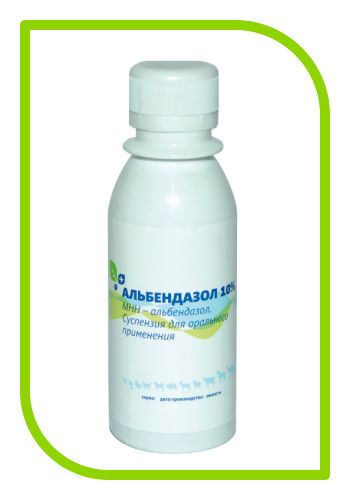Anthelmintic of a wide spectrum of action
INSTRUCTIONS of using Albendazole 2.5%, 10%, 20% in veterinary medicine
(Organization-developer: “BioKhimPharm”, Raduzhny, Vladimir region).
I. General information
1. Trade name of the drug: Albendazole 2.5%. International non-proprietary name: albendazole.
2. Dosage form: suspension for oral administration. Albendatim 2.5%, 10%, 20% as an active ingredient in 1 ml contains 25 mg, 100 mg and 200 mg of albendazole, respectively. The preparation I put out packaged in glass bottles, ukuporennye rubber stoppers and obkatannye aluminum caps, bottles and jerricans from polymeric materials with screwed up stoppers. Other packing is allowed upon agreement in the established order.
3. The shelf life of the medicinal product under the storage conditions is 3 years from the date of manufacture. It is forbidden to use Albendatim 2.5%, 10%, 20% after the expiry date.
4. Store the preparation in the manufacturer’s closed container in a dry, dark place at a temperature from minus 2 0C to 15 ° C.
5. Albendazole 2.5%, 10%, 20% should be stored in places inaccessible to children.
6. An unused product with expired shelf life is disposed of in accordance with the law.
II. Pharmacological properties
7. Pharmacotherapeutic group of medicinal product: anthelmintic agent. Albendatim, which is a part of the preparation, has a wide spectrum of anthelminthic activity, is active against imago and larvae of nematodes, trematodes, as well as imago cestodes. Possessing an ovocidal effect, it ensures a decrease in the contamination of pastures by helminth eggs. The mechanism of action of albendazole is a violation of the processes of transport of glucose and microtubule function, a decrease in the activity of fumarate reductase in helminths, a violation of the permeability of cell membranes and muscle innervation, which causes paralysis and death of helminths. With oral administration of the drug, albendazole is absorbed from the gastrointestinal tract and penetrates into the organs and tissues; the maximum concentration in the blood serum is observed after 12-25 h after application. Albendazole is excreted from the body mainly with urine and bile in unchanged form and in the form of metabolites. By the degree of exposure to the body, Albendazole 2.5% refers to moderately hazardous substances (hazard class 3 according to GOST 12.1.007-76): LD50 when administered orally to white mice is about 3000 mg / kg; in recommended doses is well tolerated by animals, does not possess a hepatotoxic and sensitizing effect.
III. The order of application
8. Albendazole 2.5%, 10%, 20% are used for de-worming farm animals and poultry with a therapeutic and prophylactic purpose for helminthiases caused by drug-susceptible pathogens.
9. The drug is contraindicated in animals in the breeding season, infertile cows in the first third of pregnancy, sucking sheep, goats and pregnant sows in the first half of pregnancy, and weakened, exhausted, with acute form of fascioliasis and sick infectious diseases.
10. Before use, the medication in the vial should be shaken thoroughly. The preparation is administered once orally to the animals in the following doses: – for cattle with moniesia, pulmonary and gastrointestinal nematodes – preparation 2.5% – 3 ml, 10% – 0.75 ml, 20% – 0.375 ml per 10 kg of body weight An animal (7.5 mg / kg by weight of the active substance); with chronic fascioliasis – the preparation 2.5% – 4 ml, 10% – 1 ml, 20% – 0.5 ml per 10 kg body weight of the animal (10 mg / kg by weight of the active ingredient); – small cattle with moniesiosis, pulmonary and gastrointestinal nematodes – preparation 2.5% – 2 ml, 10% – 0.5 ml, 20% – 0.25 ml per 10 kg of animal weight (5 mg / kg body weight active ingredient); with chronic fascioliasis and chronic dicrocoliosis – preparation 2.5% – 3 ml 10% – 0.75 ml, 20% – 0.375 ml per 10 kg of animal weight (7.5 mg / kg by weight of active ingredient); – pigs with ascariasis and esophagostomy – drug 2.5% – 2 ml 10% – 0.5 ml, 20% – 0.25 ml per 10 kg of animal weight (5 mg / kg by weight of the active ingredient). – horses for treatment and prophylaxis of parascarriosis and strongylatoses, as well as for mixed parascaridose-strontyliasis invasion, are administered individually with food once – the drug is 2.5% – 3 ml, 10% – 0.75 ml, 20% – 0.375 ml per 10 kg of body weight An animal (10 mg / kg by weight of the active substance); – Fur animals are assigned individually or in a group way, and dogs and cats individually in the morning feeding in a mixture with a small amount of feed, twice a day (two consecutive days) in a single dose – the drug 2.5% – 3 ml 10% – 0.75 ml, 20% – 0.375 ml per 10 kg of animal weight (7.5 mg / kg by weight of the active substance); – poultry for ascariasis and heterokeridosis are used in a group way for two days in a row in morning feeding mixed with mixed feed in a dose – the preparation is 2.5% – 4 ml, 10% – 1 ml, 20% – 0.5 ml per 10 kg of poultry (10 mg / kg body weight of the active ingredient). A special diet and application of laxatives to animals before deworming is not required. The drug is administered to animals in the oral cavity with a special syringe dispenser. To distribute the preparation evenly, the suspension is shaken before use. Deworming animals for therapeutic purposes is carried out according to indications, with preventive – in the spring before pasture on pasture and in autumn before staging. Before mass treatments, each series of the drug is pre-tested on a small group of animals (10-15 heads), followed by observation for 3 days. In the absence of complications, the drug is used throughout the livestock.
11. The drug is slightly toxic, and does not cause overdose in recommended doses of symptoms. Toxic poisoning is possible only when taking the drug in highly overestimated quantities.
12. The characteristics of Albendazole 2.5%, 10%, 20% at the beginning of application or when it was withdrawn is not revealed.
13. Passage of the next dose of the drug should be avoided, as this may lead to a decrease in therapeutic effectiveness. In the case of missing one or more doses, the drug is resumed as soon as possible in the same dosage and according to the same schedule.
14. Adverse events and complications with the use of Albendazole 2.5%, 10%, 20% in accordance with this instruction is not established.
15. The use of albendazole 2.5%, 10%, 20% does not exclude the use of other drugs.
16. Slaughter of animals for meat is allowed no earlier than 20 days, birds – 5 days after deworming. When forced to slaughter earlier specified terms, the meat can be used to feed carnivores or to produce meat-bone meal. Milk from milking animals and eggs from laying hens should not be used for food purposes within 4 days after deworming. They can be used after heat treatment in animal feed.
IV. Precautionary measures
17. When working with Albendazole 2.5%, 10%, 20%, the general rules of personal hygiene and safety precautions provided for working with animal medicines should be observed. 18. When working with the drug, it is forbidden to drink, smoke and eat. After working with Albendazole, 2.5% should be washed with soap and water. 19. If Albendatim gets 2.5%, 10%, 20% on the skin, it should be washed with soap and water. Mucous membranes when they get on the drug must be rinsed with a jet of clean water. If necessary, consult a doctor.






